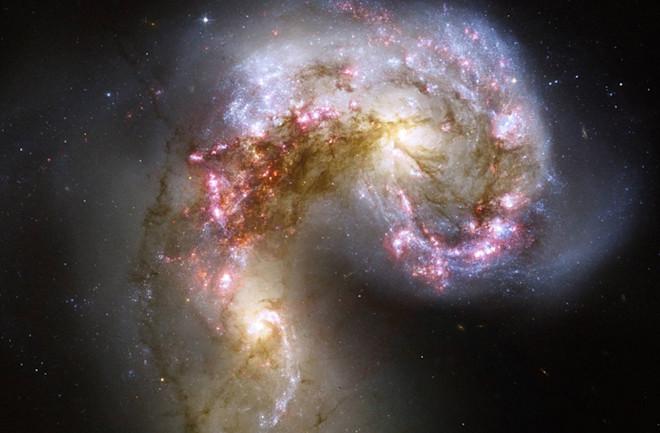20 Things You Didn't Know About Galaxies
:
The Milky Way rotates at 560,000 miles per hour and completes a full revolution every 200 million years. Here are 20 fascinating things you didn't know about galaxies that reveal the incredible scale and dynamics of our universe.
1. Immanuel Kant's Island Universe Theory
Eighteenth-century philosopher Immanuel Kant was among the first to theorize that the Milky Way wasn't the only galaxy in the universe. Kant coined the term "island universe" to describe a galaxy, laying the groundwork for modern galactic astronomy.
2. 100 Billion Galaxies in the Observable Universe
Astronomers now estimate there are 100 billion galaxies in the observable universe, a number that continues to astound scientists and stargazers alike.
3. Chaucer's Celestial Roadway
One of the earliest uses of the English term "Milky Way" appeared in Geoffrey Chaucer's 14th-century poem "The House of Fame," where he likened the galaxy to a celestial roadway.
4. Galaxies Are Speeding Away From Us
Due to the expansion of the universe, most other galaxies are receding from our own. Galaxies farther from the Milky Way are speeding away faster than those nearby, demonstrating the ongoing expansion of space itself.
5. Ellipsoidal Galaxies Resemble Footballs
Some galaxies receding from the Milky Way are ellipsoidal, resembling footballs. Others are thin and flat with tentacle-like arms, similar to our own galaxy's spiral structure.
6. Dwarf Galaxies Are the Smallest
Galaxies come in irregular shapes, including dwarf galaxies. These are the smallest galaxies in the universe, containing only a few hundred or a few thousand stars compared to the Milky Way's 100 billion stars.
7. Dwarf Galaxies Cluster Around Larger Ones
You'll often find dwarf galaxies clustered around larger galaxies, forming gravitational relationships that shape galactic evolution.
8. Dwarf Galaxies Lose Stars to Larger Neighbors
Dwarf galaxies frequently lose their stars to larger neighbors via gravity. The stars stream across the sky as the dwarf galaxies are torn apart, though this process isn't visible to the naked eye.
9. The Milky Way's Hidden Black Hole
You can't see the enormous black hole lurking in the center of the Milky Way with the naked eye, though if you've ever looked at the constellation Sagittarius, you've looked in the right direction.

10. Most Galaxies Have Central Black Holes
Most galaxies have a black hole at their center, and astronomers have found the mass is consistently about 1/1000th the mass of the host galaxy.
11. Magellanic Clouds May Lack Black Holes
Two of the closest galaxies to the Milky Way—the Small Magellanic Cloud and the Large Magellanic Cloud—may not have black holes. Alternatively, because both are low-mass galaxies, their central black holes may be too small to detect.
12. Every Galaxy Contains Dust
Every galaxy contains dust produced by stars. This dust causes light to appear redder than it actually is when observed visually, which can make it difficult for astronomers studying stellar properties.
13. Galactic Dust Can Travel Far
That dust can travel significant distances. Some galaxies drive galactic winds, expelling dust and gas at hundreds of kilometers per second into the intergalactic medium—the space between galaxies.
14. Starlight Creates Galactic Winds
These winds are caused by starlight exerting pressure on dust and gas. The fastest galactic winds occur in distant galaxies forming stars more rapidly than the Milky Way.
15. The Milky Way Completes a Revolution Every 200 Million Years
The Milky Way rotates at approximately 250 kilometers per second (about 560,000 mph) and completes a full revolution about every 200 million years.
16. One Galactic Revolution Ago, Dinosaurs Ruled Earth
One galactic revolution ago, dinosaurs ruled the Earth, showing the immense timescales involved in galactic motion.
17. Dark Matter Powers Galactic Rotation
Galaxies rotate faster than predicted based on the gravity of their stars alone. Astronomers infer that the extra gravitational force comes from dark matter, which doesn't emit or reflect light.
18. Galaxies Are Mostly Empty Space
Dark matter aside, galaxies are mostly empty space. If the stars within galaxies were shrunk to the size of oranges, they would be separated by 4,800 kilometers (3,000 miles).
19. Galaxies Are Relatively Close Together
If galaxies were shrunk to the size of apples, neighboring galaxies would only be a few meters apart. The relative proximity of galaxies means they occasionally merge.
20. The Milky Way Will Merge With Andromeda
In about 4 billion years, the Milky Way will merge with the Andromeda galaxy. The merging process—which will take at least a hundred million years—will result in an ellipsoidal galaxy nicknamed "Milkomeda."
Conclusion: The Vast Wonder of Galaxies
From Immanuel Kant's pioneering theory of island universes to our modern understanding of 100 billion galaxies scattered across the observable universe, our knowledge of these cosmic structures has expanded dramatically. Galaxies come in diverse shapes and sizes—from massive spiral galaxies like our Milky Way to tiny dwarf galaxies with just a few thousand stars. They rotate at incredible speeds, harbor supermassive black holes at their centers, and are powered by mysterious dark matter that we still don't fully understand.
These cosmic islands are far from static. They interact, collide, and merge over billions of years, driven by gravitational forces that stretch across millions of light-years. Galactic winds carry dust and gas between galaxies, while dwarf galaxies are slowly consumed by their larger neighbors. The universe itself continues to expand, pushing most galaxies farther apart with each passing moment.
Perhaps most humbling is the realization that our own Milky Way is hurtling through space at 560,000 miles per hour, taking 200 million years to complete a single rotation. In just 4 billion years, we'll merge with Andromeda to form Milkomeda, a cosmic dance that will reshape our corner of the universe. These 20 facts remind us that we live in a dynamic, ever-changing cosmos far grander than our ancestors could have imagined.











